Your cart is currently empty!
Are Dishes with Crazing Safe to Use? 3 Hazards to Consider
Published:
Last Updated:
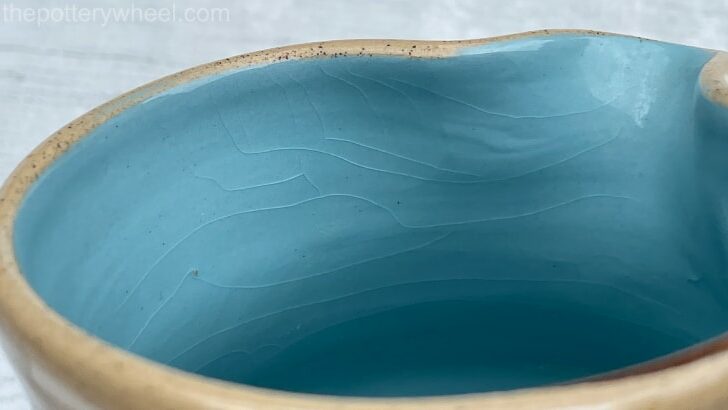
Affiliate Disclaimer
As an affiliate, we may earn a commission from qualifying purchases. We get commissions for purchases made through links on this website from Amazon and other third parties.
Crazing looks like a very fine network of cracks in the glossy glazed surface of your ceramics. If you run your finger over the fine cracks, it will most likely feel smooth. But are dishes with crazing safe to use?
No, dishes with crazing are not safe to use for food and drink. The tiny cracks in the glazed surface can allow food to seep into the deeper layers of the dishes. And bacteria can grow in the cracks themselves. Crazing also makes dishes weaker and more prone to breaking when being used.
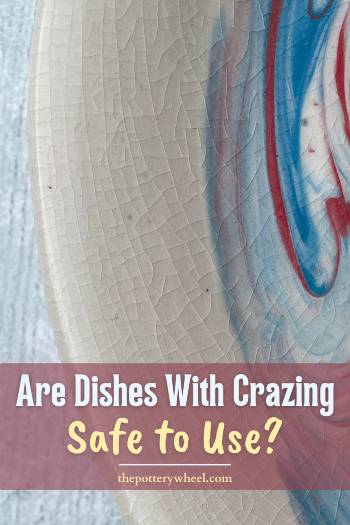
What is Crazing?
Crazing is known in the pottery world as a ‘glaze defect’. The glaze on your pottery and ceramics is the shiny hard coating on the surface of your mugs, bowls, and dishes.
Pottery glaze is partly used to decorate your ceramics. But it is also used to create a water-tight seal on your dishes so that they don’t absorb food and drink.
When pottery has been glazed well, the glaze is blemish free and creates a smooth protective coating on your dishes.
However, making a good glazed surface that seals the ceramics well is not that easy. The potter or manufacturer needs to heat the ceramics at the right temperature. This is called firing the pottery. And the chemistry in the clay and glaze needs to be right too.
Things can go wrong in the glazing process, and this can cause ‘glaze defects’. This is true whether the ceramics being made is fine china or pottery intended for everyday use.
Crazing is characterized by small cracks that form in the glaze. When crazing occurs, it will more than likely cover all of the glaze, forming a network of tiny triangles and squares.
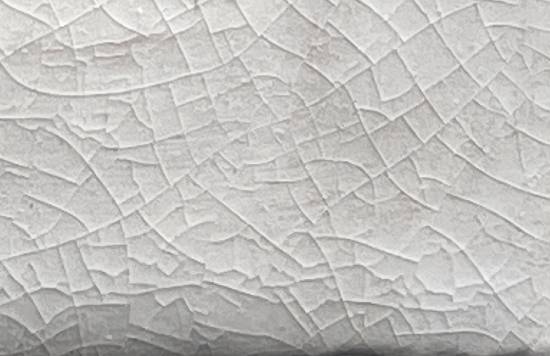
What Does Crazing Look Like on Dishes?
Sometimes crazing is very easy to spot. This is because over time the cracks in the glaze will absorb pigment from substances such as tea, coffee, and colored foods. The pigments effectively stain the cracks and make the crazing quite visible.
This is particularly true with older vintage or antique pieces that have been exposed to the elements for some time.
However, crazing is not always immediately obvious. If the crazing has occurred on a piece that has been made more recently, the cracks may be harder to spot.
It takes a while for crazing to become stained, and before it’s stained, you may have to hold the piece up to the light and inspect it quite carefully to see the fine network of cracks.
One way to test whether a dish has crazing is to draw on a section of the glazed surface with a black marker pen. Wipe the pen off with a solvent like rubbing alcohol or nail varnish remover. If the surface is crazed, the cracks will be stained by black ink.
Do remember that if you test using this method, the dark ink will stay on your ceramics. So, you may not want to try this approach on your favorite pieces.
What Causes Crazing on Dishes?
There are a few factors that contribute to cracks forming on your ceramics. However, the main reason that crazing occurs is to do with the way the ceramics have been glazed.
When ceramics are made they are heated at high temperatures. Usually, ceramics that are intended to be used for food and drink is fired at 2200F (1200C) or higher.
When it’s fired, the glaze melts onto the ceramics and forms a smooth liquid coat. As ceramics cools down, the glaze becomes a hard glossy layer.
For the glaze to form a strong protective barrier, the clay and glaze need to fit well together. When the pottery is being fired in the kiln, the clay expands as it heats up. At this point, the glaze is a melted liquid.
As the clay cools down, it shrinks a bit. The glaze also needs to shrink by the same amount if the clay and glaze are going to ‘fit’ each other.
If the glaze shrinks more than the clay, the glaze is stretched and put under a lot of tension. It is this tension that causes the glaze to crack and for crazing to occur.
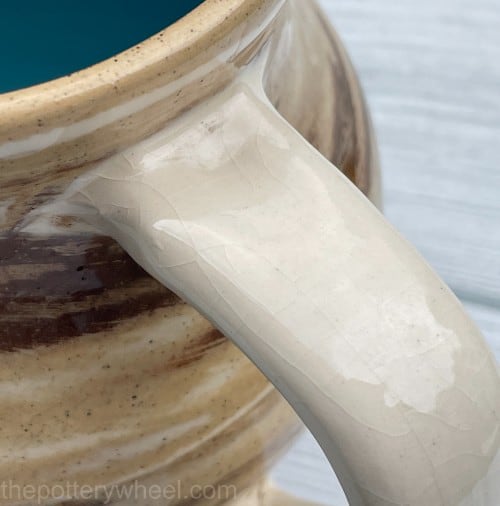
At What Point Does Crazing Occur?
Sometimes the glaze will crack and craze as soon as the piece has been manufactured. However, sometimes the glaze will manage to withstand the tension it’s under for months, and sometimes years.
But with time, wear and tear will weaken the glaze further and eventually it will give in to the tension that it’s under and cracks will appear.
It’s sometimes said that crazing is caused because the dishes have been handled too roughly. Or alternatively, it’s said that it can be caused by storing the ceramics in a place where the temperature fluctuates. An example of this might be a garage that gets very cold in the winter and very warm in the summer.
Whilst wear and tear like this can be a trigger for the crazing to begin, the actual underlying cause is that the glaze is under too much tension. As a result, you can’t prevent crazing from happening. If the glaze is under strain, it’s going to craze at some point, it’s just a matter of time.
Crazing can also occur later on in the life cycle of a dish if that dish is made from earthenware clay. The reason for this is that earthenware ceramics are porous and will absorb moisture over time.
Earthenware ceramics can absorb moisture from the atmosphere, even if they aren’t submerged in water. As the earthenware absorbs moisture, the ceramic body expands just a fraction. But a tiny bit of expansion is enough to put glaze under strain.
This small increase in the size of the ceramics is enough to cause crazing in older earthenware pottery.
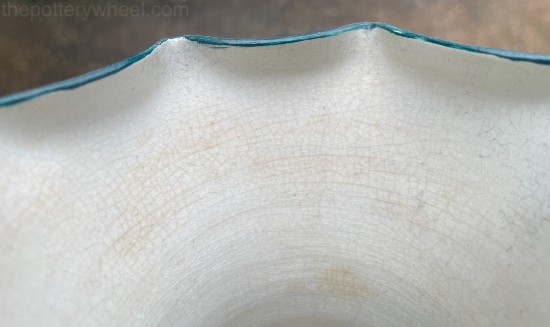
Is it Safe to Use Dishes with Crazing for Food and Drink?
Generally speaking, it’s recommended that you don’t use dishes that are crazed for food and drink.
There are a few reasons for this and here are the key concerns about crazed dishes:
1) Harboring Bacteria
The cracks in a crazed surface can act as a nesting place for bacteria. For this reason, it’s generally recommended that you don’t use crazed dishes for food and drink.
Ceramics manufacturers usually don’t sell items with crazed glaze for items that will come into contact with food. And in 2013, the FDA published the Food Code guidelines. These guidelines state that surfaces that come into contact with food used by restaurants should be free of crazing and other irregularities.
But what do we do with any dishes that we own that do have crazing? Are they ok to use or not? Depending on who you speak to you will probably get different answers to that question.
However, there is some consensus in the pottery-making community that there are levels of risk.
For example, if you have the odd cup of coffee now and again from a mug that has some crazing, it’s unlikely to do any harm. By contrast, storing or cooking food in a crazed dish is considered more risky. Keeping your dishes in a crazed container, or heating the dish increases the chance that any bacteria will multiply and cause problems (source).
One of the problems that can arise from using crazed dishes for cooking or storage, is the issue of contamination.
2) Risk of Contamination
Crazing in glaze is not just a surface issue. When a glaze cracks the crack will extend from the surface of the glaze to the underlying clay body underneath. So, when food and drink get into the crack, they also have access to the underlying ceramic body.
As a result, it’s not just that the food and drink nestle in the crazing, they can actually be absorbed by the ceramic body itself.
This is more of an issue for earthenware pottery. As mentioned a little earlier, earthenware ceramics are porous and absorbent. So, if the juices from your stew get into the cracks in the glaze they may be absorbed into the actual dish itself.
When the dish is reheated to cook something else, the juices from your previous meal may seep out from beneath the glaze and into your new food.
Not only is this unhygienic, but it raises issues around allergies. For example, if you cook a nut roast in your dish, traces of nut may contaminate the next meal you cook.
Stoneware ceramics and porcelain are not porous, so the issue of cross-contamination is less of a concern.
However, stoneware and porcelain are only non-porous if they have been fired correctly. So, you are trusting that the method of production was adequate. And if your dish has crazing, then it isn’t sensible to assume that it was produced correctly.
3) Crazing Weakens Pottery and Ceramics
Putting the issues of bacteria and contamination to one side, there is another problem caused by crazing. Crazing actually weakens the dish itself. Crazing isn’t superficial, it reaches all the way down to the ceramics beneath the glaze.
Scientist Brian Pinto explains that crazing “weakens the underlying material by placing numerous macro-sized flaws at the surface of the body” (source).
This means that the crazing actually creates flaws in the underlying ceramics. As a result, crazing can produce weak points in the pottery.
Dishes with crazing are more likely to break if they are bumped and knocked in general everyday use. And handles are more likely to come off items like mugs, pitchers, and casserole dishes.
The fact that crazing compromises the strength of your dishes means that they are not safe for use in the kitchen or dining room. You don’t want your hot casserole dish breaking as you lift it out of the oven full of piping hot food.
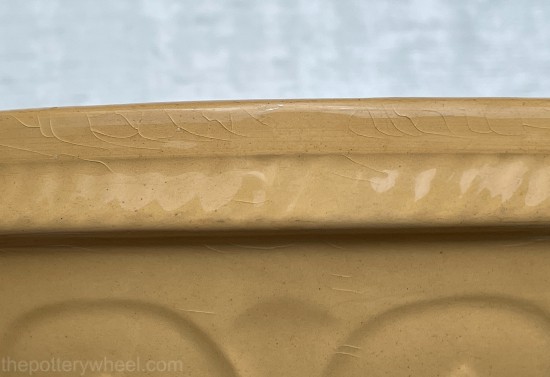
Is it Ever Safe to Use Crazed dishes?
The Ceramic Arts Network published some interesting results from research that was done in this area. They wanted to know if crazed ceramic dishes could be cleaned effectively.
After some experimentation, the researchers found the following results. Crazed surfaces do hold onto more bacteria when they are wiped clean, rinsed in water, or washed with soap and water.
However, when the dish was put into a dishwasher, the crazed and non-crazed dishes were as clean as one another. The conclusion of the article was that cleaning your dishes “well (ideally in a dishwasher) is all that needs to happen” (source).
The problem with this is that dishwashers wash at very high temperatures. And they use harsh detergents. So, not all ceramics, particularly vintage or antique ceramics should be washed in a dishwasher.
Final Thoughts
Generally speaking, it is not considered safe to use dishes with crazing for food and drink.
If you really want to use a dish that has some crazing, it would be wise to separate your food from the plate surface with a doily or some baking paper.
Nevertheless, it’s good to keep some perspective. If you happen to drink from a mug that has some crazing on it, chances are that there will be no ill effects.
However, it’s best to avoid cooking or storing your food in dishes that have crazing, as this is not considered a safe practice.



